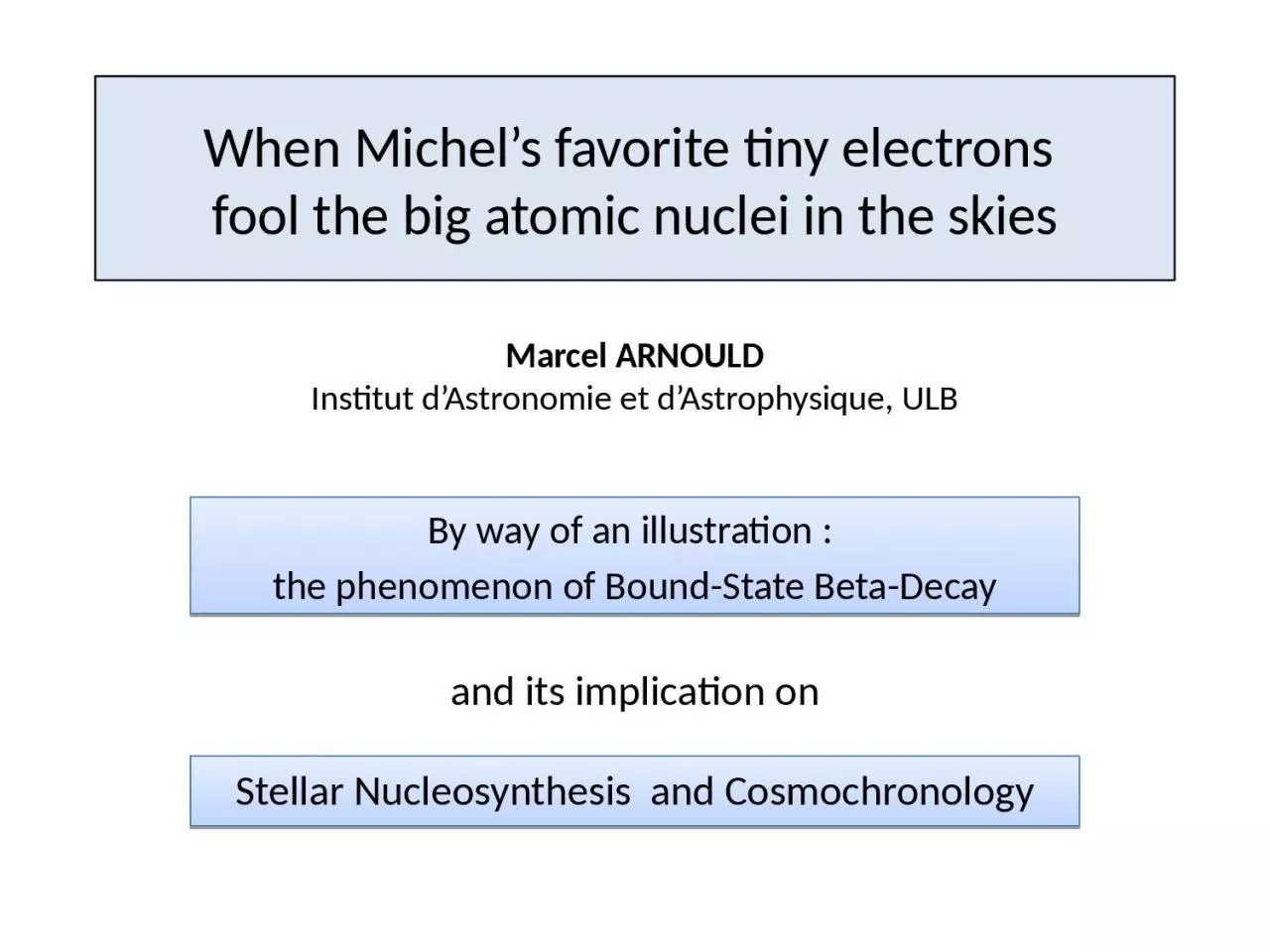

tiny electrons fool the big atomic nuclei in the skies Stellar Nucleosynthesis and Cosmochronology Marcel ARNOULD Institut dAstronomie et dAstrophysique ULB and its ID: 1040769
Download Presentation The PPT/PDF document "When Michel’s favorite" is the property of its rightful owner. Permission is granted to download and print the materials on this web site for personal, non-commercial use only, and to display it on your personal computer provided you do not modify the materials and that you retain all copyright notices contained in the materials. By downloading content from our website, you accept the terms of this agreement.
1. When Michel’s favorite tiny electrons fool the big atomic nuclei in the skiesStellar Nucleosynthesis and CosmochronologyMarcel ARNOULDInstitut d’Astronomie et d’Astrophysique, ULBand its implication onBy way of an illustration : the phenomenon of Bound-State Beta-Decay
2. A brief introductionNuclear decays and reactions via weak interaction play a key role in many fields of stellar astrophysicsA larger variety of such processes can develop in stars than in the laboratoryCommon processes in normal lab conditions: (Z,N) --> (Z+1, N–1) + + : (Z,N) --> (Z-1, N+1) + + n Bound Electron Capture : (Z,N)+ eb_ --> (Z-1, N+1) + n
3. Specific Processes in Stars capture : (Z,N) + ec_ --> (Z-1, N+1) + nPositron Capture : (Z,N) + e+ --> (Z+1, N-1) + Bound-State b-Decay : (Z,N) --> (Z+1, N-1) + In additionA large variety of Neutrino-Nucleus Interaction processes including Neutral-Current processes
4. Temperature effects: Decay of thermally populated nuclear excited statesTemperature + density effects:Reduction of emitted lepton phase space (Pauli principle) at high density + low temp. (Fermi-Dirac statistics)Capture of e+ , free e- : Exo -, as well as endothermic transitions possible (Fermi energy)Ionization : Bound e- rate = f (stellar conditions) (e.g. 7Be)Bound state b-decayStellar plasma conditions affect b-decay processes in many waysSTARS = WORLD OF VARIABLE DECAY CONSTANTS !
5. MeasurementsBack to Bound-State Beta-Decay19471983-19871992199619612005Prediction Daudel et al.BahcallTakahashi and YokoiCalculation probabilities163DyJung et al.187ReBosch et al.205Tl Bound/continuumOktsubo et al.ESR: Experimental Storage Ring GSI DarmstadtRemarkable Agreement !
6. An Obvious Pre-requisite : vacancies in atomic shells (esp. lowest energy ones)Population of ionized states in local thermodynamic equilibrium : Saha equationPopulation of given atomic state = f(T, ρ, mass ions, ionization potentials, atomic partition function) Note complication: atomic states of ion perturbed by : Other bound electronsSurrounding free electrons/ions
7. Ionisation potentials in stars smaller than laboratory values (« Depression of continuum »)Another important requirement:The emitted electron must have a low enough energy to efficiently populate a vacant atomic state(Much work for atomic physicists !!)
8. Complications in the calculation of energetics of transitionQn = Neutral atom ground state mass difference has to be correctedDifferences between energies of initial and final atomic states involved and total binding energies of electron clouds in initial and final ionsDepression of continuum(see Takahashi and Yokoi, Nucl. Phys. A404, 578, 1983 for details)
9. Complete ionizationAllowed transitions onlyComparison between bound-state beta-decay and normal beta--decay
10. The Bound-State Beta-Decay and Nucleo-CosmochronologyEvaluation of the age of Solar System nuclides Tnuc (time between beginning of galactic nucleosynthesis in disc and present epoch ≈ « age of Galaxy » TG) Basis : use a suitable chronometric pair A (unstable) – B (stable/unstable)Requirements for a good pairDecay half-life accurately knownHalf-life commensurable with galactic ageAccurate abundance data in present Solar System (meteorites) A/B│TG (obs) (age of solar system known ~ 4.6 Gyr)Good model for evolution of the nuclidic content of galactic disc up to time of isolation of Solar System (a formidable problem !) A/B│TG(th) A/B│TG (obs) A/B│TG (th) TG
11. Most famed chronometric pairs for evaluation of TG232Th (1.4 1010 y)/238U (4.5 109 y)235U (7 108 y)/238U (4.5 109 y)Poor predictive power !(Yokoi et al., Astron. Astrophys. 117 (1983) 65)187Re (4.4 1010 y)/187Os (stable)(Reasonable) Hope !Most famed chronometric pairs for evaluation of TG
12. The 187 Re- 187Os PairADVANTAGESApart from radiogenic (187Os)RAD contribution from 187Re decay, 187Os made in s-process(187Os)RAD = (187Os)Θ- (187Os)sSome problems, but …INCONVENIENTS187Re clock runs differently in different stellar zones, interstellar medium!Bound state Beta decay!187Os (EC) 187Re in certain stellar zonesDifficulties in predicting yields from individual starsDifficulties in predicting galactic 187Re content at given time 0< t ≤ TG
13. 3/2–5/2+1/2–187Os75+(K shell)187Re75+Number of electrons bound to 187Re9.75 keV Q=63.22keVt1/2 [y]Beta-Decays in stellar plasmas and ionization The case of 187Re5/2+~5X1010 yr187Re75b-187Os762.66 keV ½-134 keV3/2-9.75 keV
14. Bound-state Beta-Decays in centrally H-burning stars
15. And now, the ultimate step !… Put all the necessary ingredients [geochemical data, astronomical observations, astrophysical modellings, nuclear, atomic experiments and theory] into the grand galactic blenderWhat comes out from the Re-Os recipe : 13 < TG < 18 Gyr(Latest news from Takahashi, Nucl. Phys. A718 (2003) 325c)Not incompatible with other chronometric predictionsClearly still a long way to go to improve predictions~~
16. Michel …..!!! Your help would be greatly appreciated !!!You will have plenty of free time soon … to become an astrophysicist at last
17. Illustration impact of bound-state beta-decay on nucleosynthesis : the case of the production of 164ErProduction of the nuclides heavier than iron : the s-, r- and p- processes164Er (Z=68, N=96) : An s- or/and p- process origin ?All p-process models largely underproduce 164Ers-process models cannot produce 164Er, … except if bound-state b-decay is invoked !
18. CONC. 1
19. 949698162164166160162164Er 68Ho 67Dy 66« Normal » s-Process paths- process path with 163Dy Bound-State Beta-Decaye-b+b-St(n,g)b-e-Details of the s-process path 164ErCONC. 2
20. The Bound State Beta-Decay of 163Dy9/2- 167.349/2- 100.07/2- 73.447/2- 4750y5/2- 163Dy 163 Ho2.6 keVBound-State Beta-Decay from excited statesContinuum electron captures from excited statesTakahashi and Yokoi (1983)With Bound-State Beta-Decay, the s-process could account for the solar 164Er contentCONC. 3
21. S-Process production of 186Os, 187Os186Os187Os185Re186Re187Re184W185W186W187WZN767574110111112113ϐ-(n,g)e-cGround-state (n,g) cross sections known experimentally … but complication due to contribution to (n,g) rates of populated nuclear excited states (esp. 9.75 keV first excited state of 187Os)(some recent experimental and theoretical results, but some uncertainties remain)CONC. 4
22. The galactic blenderCONC. 5